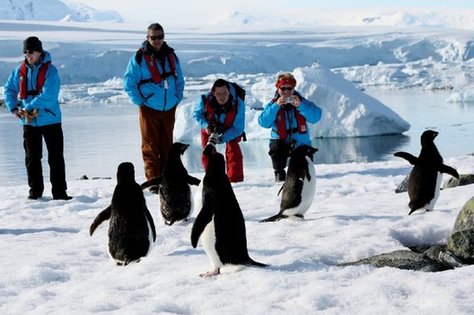Growing tourism industry brings risk of disaster to Antarctic
 0 Comment(s)
0 Comment(s) Print
Print E-mail Xinhua, September 20, 2012
E-mail Xinhua, September 20, 2012
 |
|
Visitors and penguins in Antarctica. [File photo] |
A New Zealand academic Thursday called for greater regulation of tour companies that take thousands of tourists to the Antarctic each year in order to preserve the environment and wildlife of the frozen continent.
University of Canterbury social scientist Daniela Liggett said the number of tourists to the Antarctic had grown dramatically over the last few decades, along with the risk of a disastrous accident.
Fewer than 500 tourists had visited the Antarctic annually in the mid-1960s, when commercial tourism became firmly established, Liggett said in a statement.
Visitor numbers had peaked in 2007-2008 with 46,265 tourists going to the Antarctic, but last season saw only 26,519 visitors, largely due to the global economic crisis and a ban on the use of heavy fuel oil in the Antarctic Treaty area, making cruise tourism more expensive for operators.
Tourism would continue, but it was important to ensure it was run in a conscientious, safe and environmentally sound manner, Liggett said.
One risk was that large, not ice-strengthened ships might run into problems in Antarctic waters.
"Serious accidents could be caused by collisions with ice or rocks in poorly charted Antarctic waters, and there is insufficient capacity to rescue crew and passengers from a large ship carrying more than 500 or even 1,000 tourists if that vessel had any incident or accident," Liggett said.
"Flights over penguin colonies or handling of penguins increase their anxiety and heart rate as research has shown. Viewing them from a safe distance has less of an impact and a visitor code of conduct mandates a distance of 5 meters to be kept from penguins," she said.
"However, we must not forget the indirect impacts, such as climate change, our activities have on the habitat of penguins and other wildlife."
Other environmental impacts from tourism included pollution, such as residual hydraulic fluid might escaping from ship propellers and engine shafts; accidental littering due to strong winds blowing away plastic bags and pieces of clothing; and noise and air pollution.
"Antarctic tourism has a significant carbon footprint that is often forgotten when we discuss the effects Antarctic tourism has on the environment," she said.
The International Association of Antarctica Tour Operators ( IAATO) had no sanctioning power over those operating outside the industry association, so policy makers would have to work with tour operators to develop practical, sensible and strategic regulatory processes.
Despite the challenges associated with Antarctic tourism, its benefits included generating greater awareness about Antarctica and encouraging visitors to contribute to environmental and conservation causes, she said.
Tour operators occasionally provided free passage to Antarctica for scientists or carried equipment, and tourists and tour operators could assume the role of watchdog, monitoring the activities of scientists and other visitors to the Antarctic.






Go to Forum >>0 Comment(s)